British and European Car Spotters Guide - 1935 |
|
|
 |
|
|
|
Motor vehicle production in the United Kingdom during the 1935 calendar year broke all previous records, with a total of well over 400,000, namely 325,192 private cars, 91,707 trucks and buses and some 9,100 tractors. About a quarter of a million people were now employed in the motor manufacturing and repair industries. Export figures for 1935 showed a healthy increase with 54,520 cars finding their way overseas, valued at £6,368,875. Commonwealth countries, such as Australia, were the principal export markets but in a relatively small, although quite near, country like the Netherlands most British cars were available.
A total of 13,563 cars and car chassis was imported, valued at over £2.1 million. Motor vehicles in use in the United Kingdom in September, 1935, numbered 2,034,589, about three quarters of these being private cars. During the calendar year ending December 1935, there were 413,765 new vehicle registrations; of these 281,388 were private cars and just under seven thousand hackneys. |
 |
 |
 |
AC Acedes 2 liter 16/56 and 16/66 |
| |
Also see: AC Car Reviews | The History of AC (AUS Edition) |
| |
AC (Acedes) continued their 16/56 and 16/66 models. The £450 Sports Four-seater of the latter range is shown. It had a 1990-cc (65 x 100 mm) three-carburetor 66-bhp OHC engine, rated at 15.7 HP. Wheelbase was 9 ft 7 in. tire size 5'00-19. In the 1935 Monte Carlo Rally three ACs entered and all finished, including Miss M. Alien, the first British woman competitor in the rally, who drove an AC from Umea, Sweden. |
|
 |
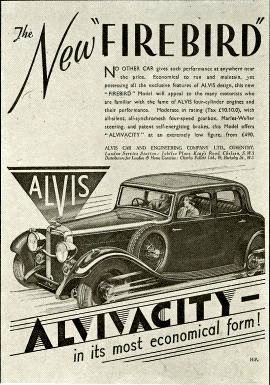 |
 |
Alvis Firebird |
| |
Also see: Alvis Car Reviews | The History of Alvis |
| |
Alvis Firebird range comprised four-seater Sports, Saloon (pictured left) and Drophead coupe models. The 9 ft 1O ½ in wheelbase chassis was also available for special coachwork, at £410. The engine was an 1842-cc (73x110 mm) OHV Four, rated at 13,22 HP. actual output being 61 bhp at 4300 rpm. Six-cylinder models were the Silver Eagle Sixteen, Crested Eagle and Speed Twenty, priced at up to £850. |
|
 |
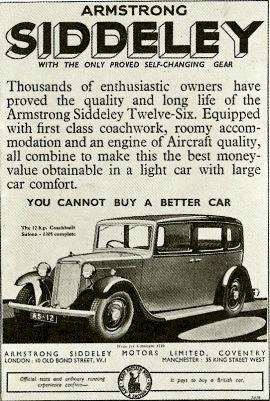 |
 |
Armstrong Siddeley Twelve-Six, Fifteen, Twenty, Long Twenty, Special |
| |
Also see: The History of Armstrong-Siddeley |
| |
Armstrong Siddeley offered Twelve-Six (left), Fifteen, Twenty, Long Twenty and Siddeley Special models. Later in the year a new model, the Seventeen, was introduced. The 1935 Fifteen had permanently-fitted hydraulic jacks. All had six-cylinder engines and self-changing gearboxes. The 4·96-liter Special models featured twin SU carburetors. |
|
 |
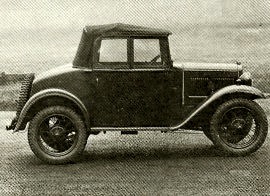 |
 |
Austin Seven Two-seater in Service Dress |
| |
Also see: Austin Car Reviews | The History of Austin (AUS Edition) |
| |
This was basically the 1934/35 civilian model. with only minor modifications Nearly 900 of this version were delivered to the British Army. It superseded the earlier type which had military pattern bodywork and was popularly known as 'the pram'. |
|
 |
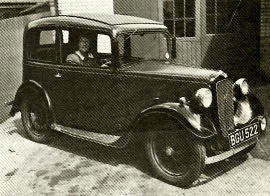 |
 |
Austin Seven Ruby De Luxe Saloon |
| |
Also see: Austin Car Reviews | The History of Austin (AUS Edition) |
| |
The Seven Ruby De Luxe Saloon was one of a wide range of models in the popular Austin economy range. Like the other Austin ranges the bodywork had been entirely restyled for the 1935 model year (commencing July 1934). It was generally more rounded, with slightly sloping radiator grille and shell painted to match the coachwork, longer bonnet with ventilator doors matching the scuttle ventilator, radiator filler under the bonnet, strengthened and lowered frame and other improvements. The Ruby had a 747·5-cc (56 x 76 mm) 12-bhp side-valve four-cylinder rubber-mounted engine, rated at 7·8 HP. with four-speed synchromesh gearbox. Wheelbase was 6 ft 9 in. tire size 4·00-17. It cost £120; the basic version, without sliding roof, was available at £112. |
|
 |
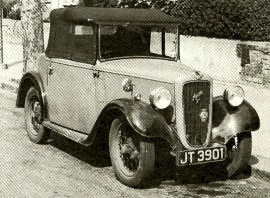 |
 |
Austin Seven Two-seater |
| |
Also see: Austin Car Reviews | The History of Austin (AUS Edition) |
| |
The Austin Seven Two-Seater for 1935 selling season was initially a continuation of the earlier square style, designated Opal. The Opal and the four-seater Open Road Tourer, in fact, retained the 1933/34 high frame until well into the 1935 model year. The Two-seater pictured left is of the later type, registered towards the end of 1935. The Nippy and Speedy Sports Two seaters were also continued with the earlier body styling. |
|
 |
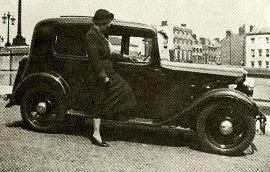 |
 |
Austin Ten-Four Lichfield Saloon |
| |
Also see: Austin Car Reviews | The History of Austin (AUS Edition) |
| |
Austin Ten-Four Lichfield Saloon looked much like the Seven Ruby but had four doors and was larger with one foot more wheelbase and overall length. It had an 1125-cc (63·5 x 89 mm) 20-bhp L-head Four engine, rated at 9·9 HP. Body style variants included the Colwyn Cabriolet, Clifton Two-seater and Ripley Sports. |
|
 |
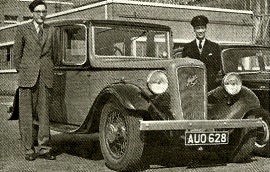 |
 |
Austin Sixteen-Six |
| |
Also see: Austin Car Reviews | The History of Austin (AUS Edition) |
| |
The Austin Sixteen-Six could be ordered with Hayes self-selector automatic gearbox at extra cost. Pictured left is a car equipped with the Hayes self-selector, being presented to the Austin Motor Co in 1961 by Mr R. J. Wyatt. Secretary of the Vintage Austin Register. |
|
 |
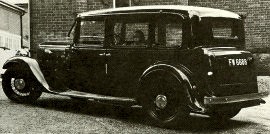 |
 |
Austin Eighteen-Six |
| |
Also see: Austin Car Reviews | The History of Austin (AUS Edition) |
| |
The Austin Eighteen-Six looked similar to the Sixteen-Six, the reason being that the Sixteen could be supplied with either 2249-cc or 2510-cc engine. Both had 111-mm stroke but bore was 65·5 mm and 69·5 mm respectively, giving a treasury rating of 15·9 and 17·9 HP. Wheelbase was 10ft or 9 ft 4 in. depending on body style. Pictured left is a York Limousine with 17·9 HP ('Eighteen') engine and long wheelbase. |
|
 |
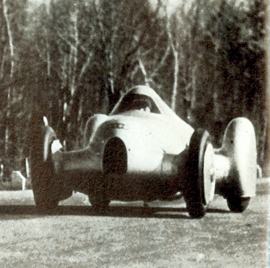 |
 |
Auto Union Speed Maker |
| |
Also see: The History of Auto-Union (AUS Edition) |
| |
Hans Stuck drove the 1935 Auto Union Speed Maker to a speed of 200mph. The autobahns were so good, even in 1935, that Stuck could use a public highway.
|
|
 |
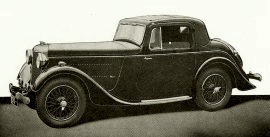 |
 |
Avon Standard 10 HP Coupe |
| |
|
| |
The Avon Standard 10 HP Coupe was built by the New Avon Body Company Ltd of Warwick, based on a 7 ft 10in wheelbase Standard. Inside the body there was room for driver, passenger and two small children and there was a dicky seat which would accommodate two medium size passengers if necessary. Engine was the Standard 1343-cc (63·5 x 1 06 mm) 32-bhp side-valve Four. Optional at a small extra cost was the Standard 12 HP 1608-cc (69·5 x 106 mm) engine with twin RAG carburetors and a higher gear ratio. |
|
 |
|
 |
Avon Standard 16 HP Open Two-Four-Seater Sports |
| |
|
| |
The Avon Standard 16 HP Open Two-Four-Seater Sports was based on the 9 ft 2 in wheellbase Standard Sixteen chassis with 2143-cc (65,5 xl 06 mm) 48-bhp six-cylinder side-valve engine. Optional extras included a 20 HP engine (Standard Twenty. 2664-cc, 60-bhp), ACE wheel discs, spare wheel cover. etc. Like the 10-12 HP models, it had a DWS permanent four-wheel jacking system as standard equipment. Also available in the 16 HP range were a Close-Coupled Coupe and a pillarless Saloon called the Waymaker 1. |
|
 |
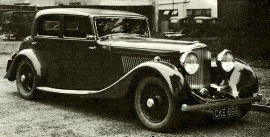 |
 |
Bentley 3 ½- liter |
| |
Also see: Bentley Car Reviews | The History of Bentley |
| |
Bentley produced one standard chassis. the 3½- liter with 10ft 6 in wheelbase. It cost £1100 and was used by various specialist coach builders. The company itself offered three types of complete cars, an Open Tourer at £1380, a Four-door Saloon at £1460 and a Drophead Coupe at £1485. The engine was a 3669-cc (82·5 x 114 mm) OHV six-cylinder, rated at 25·3 HP. Actual bhp output was not disclosed. The vehicle pictured left was a Saloon with body by Park Ward. |
|
 |
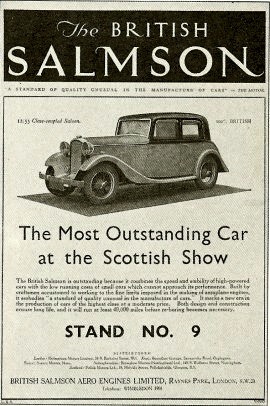 |
 |
British Salmson 12/55 |
| |
Also see: The History of Salmson and British Salmson |
| |
British Salmson 12/55 (shown) and 12/65 models were offered by the British Salmson Aero Engines Ltd. Both models had a 1470-cc (69 x 98 mm) twin-OHC four-cylinder engine. rated at 11·9 HP. The power output of the 12/55 was 55 bhp at 4500 rpm, that of the 12/65 was 65 at 5500. All had servo-assisted brakes and four-wheel jacking system as standard equipment. |
|
 |
|
 |
Brough Superior |
| |
|
| |
The Brough Superior was a Hudson-engined high-performance car designed by George Brough. Mr Brough, of Nottingham, was well-known as the designer of the famous Brough motorcycle and as holder of many awards for motoring events. The Brough Car was originally intended to be for his own use ('for my own smoking' as he put it) but in 1935 quantity production commenced, albeit on a very small scale. |
|
 |
|
 |
Brough Superior |
| |
|
| |
The Brough Superior eight-cylinder side-valve engine had a capacity of 4168 cc (76 x 114 mm) and an output of 125 bhp at 4000 rpm. The Dual Purpose car had bodywork by Atcherly of Birmingham and sold at £695. |
|
 |
|
 |
BSA 10 HP and Light Six |
| |
|
| |
BSA offered 10 HP and Light Six models, all with the Daimler Fluid Flywheel four-speed transmission. The two types differed mainly in engine specification. The 10 HP had an 1185-cc (63 x 95 mm) side-valve Four, developing 28 bhp. The Light Six engine was an OHV 1378-cc (57 x 90 mm) unit with a power output of 34 bhp. By October, 1935, a Ten Saloon De Luxe with 1330-cc (63·5 x 1 05 mm) was also available. |
|
 |
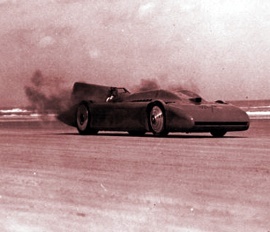 |
 |
Campbell/RolIs-Royce Bluebird |
| |
Also see: World Land Speed Records |
| |
Pictured left is the Campbell/RolIs-Royce Bluebird World Land Speed Record car. In the guise shown here it was powered by a 36½-liter 12-cylinder Rolls-Royce aero-engine, developing about 2500 bhp. The car, with which Sir Malcolm Campbell eventually broke through the 300 mph barrier in 1935, weighed close to five tons and had dual rear tires to combat wheelspin. Much of the design work had been done by Reid Railton. Visible in the background in this Reigate, Surrey, showroom is a Triumph Gloria Southern Cross Two-seater. |
|
 |
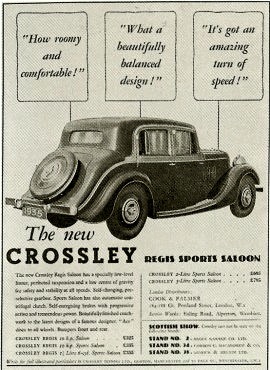 |
 |
Crossley Regis |
| |
Also see: The History of Crossley (AUS Edition) |
| |
Crossley offered five models in chassis and saloon form, all featuring pre-selective four-speed gearbox. Regis models had 9 ft wheelbase, 2 and 3 liter models 10ft 2½ in. The Regis Sports saloon pictured left had a 35½-bhp 1122-cc (63 x 90 mm) engine with overhead and side valves. |
|
 |
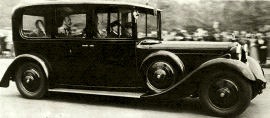 |
 |
Daimler Royal Double-Six |
| |
Also see: Daimler Car Reviews | The History of Daimler (AUS Edition) |
| |
The Daimler Royal Double-Six was one of several state cars used by King George V. The complete Daimler range for 1935 comprised five 15 HP models (45-bhp 2003-cc Six, wb 9 ft 1½ in, £450 to £475), three 20 HP models (59-bhp 2687-cc Six, wb 10 ft 4 in, £695-£795), two 25 HP Straight light models (89-bhp 3746-cc Eight wb 11 ft 10in, £1495-£1515), one 40 HP chassis (105-bhp 296-cc V12, wb 12 ft 3½ in) and one 50 HP chassis (132-bhp 6511-cc V12, wb 12 ft 3½ in). The last two had sleeve-valve engines: all others had pushrod-operated overhead valves. All models ad Fluid Flywheel with pre-selective four-speed gearbox. |
|
 |
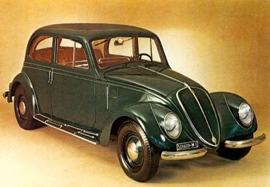 |
|
 |
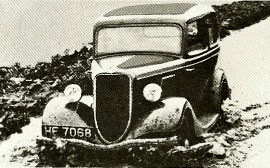 |
 |
Ford Popular 8 HP Model Y |
| |
Also see: Ford UK Car Reviews | The History of Ford |
| |
The Ford Popular 8 HP (Model Y) was continued in chassis, Tudor, Fordor and 5-cwt Van form. Pictured left is a Tudor, or Single-Entrance Saloon, negotiating a flooded road at Owston Ferry in Yorkshire. |
|
 |
|
|
 |
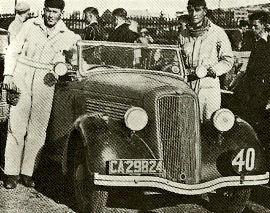 |
 |
Ford De Luxe 10 HP Model C |
| |
Also see: Ford UK Car Reviews | The History of Ford |
| |
The Ford De Luxe 10 HP Model C was a new stablemate for the Popular in 1935. It had the same 7 ft 6 in wheelbase but was roomier, more luxurious and powered by a new 1172-cc (63,5 x 92·5 mm) 10 HP 32.5-bhp side-valve engine, which was basically a larger-bore version of the Popular's 933-cc (56·6 x 92·5 mm) 7·96 HP 22-bhp unit. Within the Ford organization the Model C De Luxe was known also by the designation 20E, the Model Y Popular as 19E. Pictured left is a Ford De Luxe 10HP touring model in South Africa, after class win in the 1935 Capetown-Port Elizabeth-Capetown reliability trial. |
|
 |
 |
 |
Ford V8 |
| |
Also see: Ford UK Car Reviews | The History of Ford |
| |
The Ford V8 was available in Britain with two types of engine. The model 48 was similar in all but minor details to the North American 1935 Ford, powered by the 30 HP 90-bhp 3622-cc (77·79 x 95·25 mm) side-valve V-8-cylinder engine. The Model 60, which was externally similar to the Model 48, had the smaller 22 HP 2227-cc (66·04x81·28 mm) variant, resulting in a road tax reduction from £22 10s to £16 10s. The Model 60 was produced in Britain until 1936 when it was replaced by a new 22 HP with European style bodywork. |
|
 |
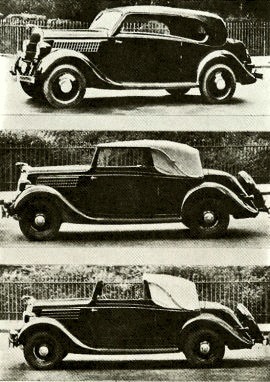 |
 |
Ford V8 Dagenham Specials |
| |
Also see: Ford UK Car Reviews | The History of Ford |
| |
The Ford V8 chassis was available for special bodywork and sold at £190 (October 1935). There were some special versions offered by Dagenham Motors Limited, such as the DM Sports Saloon (price £425) and a Foursome Drophead Coupe (£415) with the top in closed and half-open position. |
|
 |
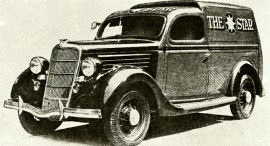 |
 |
Ford V8 "The Star" Delivery Specials |
| |
Also see: Ford UK Car Reviews | The History of Ford |
| |
Ford V8 chassis was very suitable for newspaper delivery. Pictured left is one of two vans operated by The Star. The bodywork was by G. Scammell and Nephew Limited of London. Doors and front roof section were from the Standard Saloon. |
|
 |
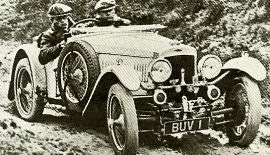 |
 |
Frazer-Nash TT Replica |
| |
Also see: The History of Frazer-Nash |
| |
The Frazer-Nash TT (1934) Replica was offered with four- or six-cylinder engine. The Four had a 1496-cc (69 x 100 mm) single-OHC power unit rated at 11·9 HP and a four-speed gearbox. Final drive to the solid rear axle was by chain. It cost £650. |
|
 |
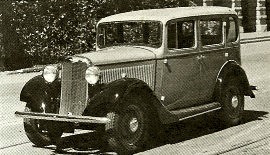 |
 |
Hillman Minx |
| |
Also see: Hillman Car Reviews | The History of Hillman (AUS Edition) |
| |
The Hillman Minx range was Rootes' 'bread and butter line', and was modified in various details for 1935. It was a very popular car and good value. Features included (quoting from the sales literature) : 'roomy comfort; draughtless ventilation; synchromesh gear-change; modernistic, sane beauty; cushioned power; cyclonic induction.' It retained the 1185-cc (63 x 95 mm) 27 -bhp side-valve engine, rated at 9·8 HP. 1935 models had a new radiator grille/shell and the filler cap under the bonnet. |
|
 |
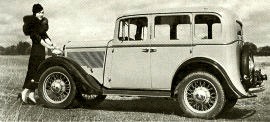 |
|
 |
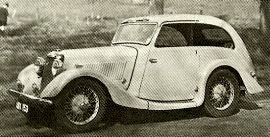 |
 |
Hillman Aero Minx Cresta Saloon |
| |
Also see: Hillman Car Reviews | The History of Hillman (AUS Edition) |
| |
The Hillman Aero Minx Cresta Saloon was a new model on the Aero Minx Safe Speed chassis. It cost £265 and the engine developed ten more brake horsepower than the standard Minx. The Cresta, Hillman proclaimed, was 'not only nippy but definitely natty'. |
|
 |
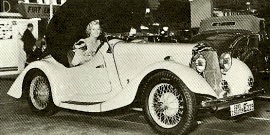 |
 |
Hillman Aero Minx Two-seater Roadster |
| |
Also see: Hillman Car Reviews | The History of Hillman (AUS Edition) |
| |
This smart little sports car was offered at a mere £225. Wheelbase of the Aero Minxes was four inches shorter than the standard models, at 7 ft 4 in. Shown in the car at the Olympia Motor Show is actress Nell Gwyn, wearing the costume used in a recent successful film. |
|
 |
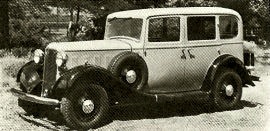 |
 |
Hillman Twenty-70 Saloon |
| |
Also see: Hillman Car Reviews | The History of Hillman (AUS Edition) |
| |
Pictured left is a Hillman Twenty-70 Saloon, one of a large fleet supplied to the Iranian Oil Company for service in South Persia. The order also included a number of pickup trucks on the same chassis. Non-standard wheels and tires were specified. |
|
 |
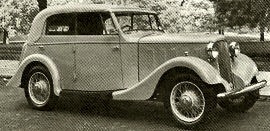 |
 |
Hillman Twenty-70 Wingham Cabriolet four-seater |
| |
Also see: Hillman Car Reviews | The History of Hillman (AUS Edition) |
| |
The Hillman Twenty-70 with Wingham Cabriolet four-seater body was offered at £395 The Twenty-70 models had a 20·9 HP 68-bhp side-valve Six engine of 281O-cc capacity. There was also the Sixteen which was similar in specification but had a 15·9 HP 50-bhp 2110-cc engine (65- instead of 75-mm bore). |
|
 |
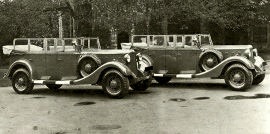 |
|
 |
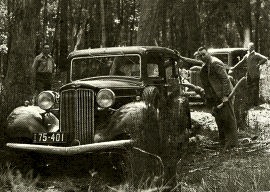 |
 |
Hillman Twenty-70 Australian Assembly |
| |
Also see: Hillman Car Reviews | The History of Hillman (AUS Edition) |
| |
Here is a Hillman Twenty-70 as assembled in Sydney, Australia. These cars differed from the British parent vehicle in various bodywork details. Note horizontal bonnet louvres. |
|
 |
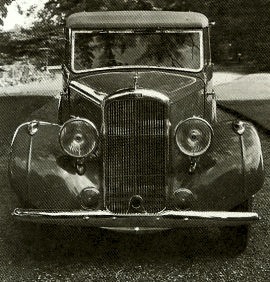 |
 |
Humber Twelve / Twelve-45 |
| |
Also see: Humber Car Reviews | The History of Humber |
| |
The Humber Twelve was virtually a new car for the 1935 selling season. It was also known as the Twelve-45 and was available as Saloon (£285), Vogue Saloon (two-door, £335) and Foursome Drophead Coupe (shown, £325). Wheelbase was 8 ft 2½ in. The cars were powered by a 1669-cc (69,5 x 110 mm) 42-bhp side-valve Four, rated at 11·98 HP. All four forward speeds had synchromesh. |
|
 |
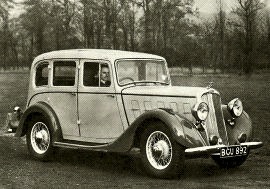 |
 |
Humber Twelve Saloon |
| |
Also see: Humber Car Reviews | The History of Humber |
| |
All Humber Twelves had a new chassis frame and the engine and radiator were mounted several inches farther forward than before. Tyre size was 5·50-17. |
|
 |
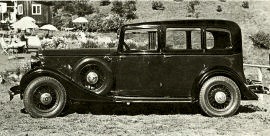 |
 |
Humber 16/60 Six-light Saloon |
| |
Also see: Humber Car Reviews | The History of Humber |
| |
Humber 16/60 Six-light Saloon, costing £435. The 16/60, the Snipe 80 and the Pullman followed similar general lines, most constructional features being common to all. The 16/60 had 10ft 4 in wheelbase chassis and bodywork similar to the Snipe 80 but its 16·9 HP six-cylinder engine was of 2276-cc capacity (67·5 x 106 mm) and developed 55 bhp at 3600 rpm. The tire size was 6·00-18. |
|
 |
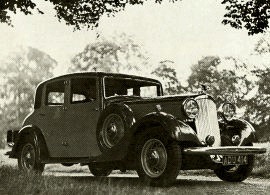 |
 |
Humber Snipe 8O Sports Saloon |
| |
Also see: Humber Car Reviews | The History of Humber |
| |
Humber Snipe 8O Sports Saloon, selling at £550, was one of five factory-built body styles available. The engine was a 23.5 HP side-valve Six of 3495-cc capacity (5Ox 116 mm), developing 77 bhp at 3400 rpm. tires were 6-50-17. |
|
 |
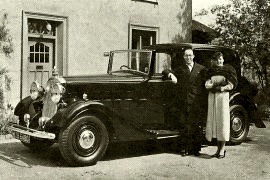 |
 |
Humber Pullman |
| |
Also see: Humber Car Reviews | The History of Humber |
| |
Humber Pullman shared 3½ liter 77-bhp engine with Snipe 80 but had 11 ft wheelbase and 7-00-1S tires. The Pullman Sedanca De Ville shown was priced at £945 and owned by Mr and Mrs Sonny Hale, the latter of course being the famous Jessie Matthews. |
|
 |
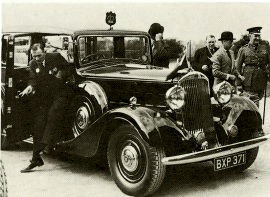 |
|
 |
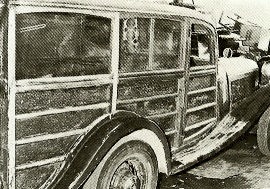 |
 |
Jensen/Ford V8 |
| |
Also see: The History of Jensen |
| |
Jensen/Ford constituted an American (Canadian) Ford V8 30 HP chassis with numerous modifications carried out by Jensens of West Bromwich. The chassis was lowered and the radiator dropped to reduce overall height. |
|
 |
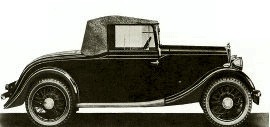 |
 |
Jowett 5G Long two-seater |
| |
Also see: Jowett Car Reviews | The History of Jowett |
| |
The Jowett 5G Long two-seater with dicky seat was later known as Flying Fox. All Jowett models were powered by a 16-bhp 907 -cc (75·4 x101·6 mm) water-cooled flat-twin engine with side valves, rated at 7·04 HP. |
|
 |
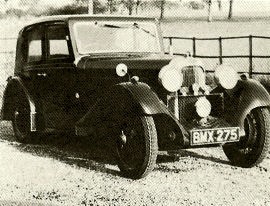 |
 |
Lagonda Rapier 10 HP |
| |
Also see: The History of Lagonda |
| |
The Lagonda Rapier 10 HP. available only in chassis form. was smallest and cheapest Lagonda offered during 1934-35. It had an 8 ft 4 in wheelbase and cost £270. The four-cylinder twin-OHC 1104-cc engine produced 45 bhp at 4500 rpm. Shown is a Pillarless Saloon by Eagle, one of only two built. |
|
 |
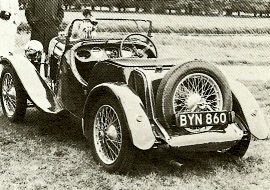 |
 |
Lagonda Rapier |
| |
Also see: The History of Lagonda |
| |
The Lagonda Rapier chassis was used chiefly for sports type cars. The production run of this attractive Two-seater by Eagle remained under twelve. |
|
 |
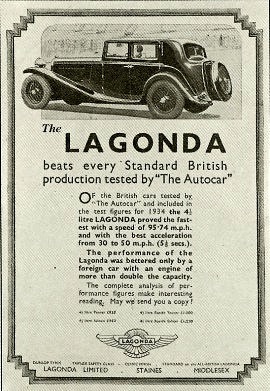 |
 |
Lagonda 4½ liter |
| |
Also see: The History of Lagonda |
| |
The Lagonda 4½ liter models came in two versions, the basic Six with 10ft 9 in wheelbase and 104-bhp engine and the Rapide with 10 ft 3 in wheelbase and 120-bhp engine. Both engines were 29·13 HP six-cylinder OHV units with 88·5-mm bore but the stroke of the Rapide engine was 120·6 vs. 120 mm. resulting in a cubic capacity of 4467 cc. Lagonda also offered smaller six-cylinder models, down to the 16/80 Special with 1991-cc engine. |
|
 |
|
 |
Lanchester 18 |
| |
Also see: The History of Lanchester |
| |
The Lanchester 18 was basically a Daimler (Lanchester had been taken over in 1931 by the BSA Group of which Daimler had been a member since 1910). The 18 had a 53-bhp 2390-cc six-cylinder OHV engine with fixed cylinder head. Transmission comprised Daimler Fluid Flywheel with self-changing gearbox. |
|
 |
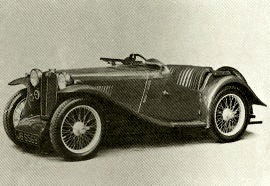 |
 |
MG P-Series |
| |
Also see: MG Car Reviews | The History of MG |
| |
The MG P-Series was developed from the J-Series and had a sturdier chassis, better brakes, three-bearing crankshaft and other refinements. The PB-type Midget of 1935/36 was available in Two-seater (shown). |
|
 |
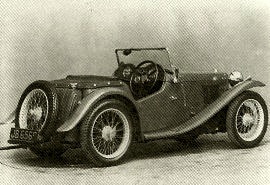 |
 |
MG P-Series |
| |
Also see: MG Car Reviews | The History of MG |
| |
The MG P-Series Four-seater and Airline Coupe variants and had a 939-cc (60 x 83 mm) four-cylinder engine, developing 43 bhp at 5500 rpm. Its immediate predecessor, the 1934 PA Midget had a 36-bhp 847-cc (57 x 83 mm) engine. Both engines had overhead camshaft, twin SU carburetors and four-speed gearbox. The PB had a slatted radiator grille instead of plain as on the PA Some 2500 of the P-Series were produced. |
|
 |
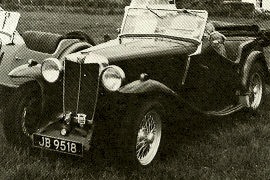 |
 |
MG NA Magnette Four-seater |
| |
Also see: MG Car Reviews | The History of MG |
| |
The MG NA Magnette Four-seater was one of several models available in the six-cylinder N-Series. It had a 1286-cc OHC engine with twin SU carburetors, developing 56 bhp at 5500 rpm, and four-speed gearbox. |
|
 |
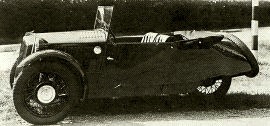 |
 |
Morgan Family Mode |
| |
Also see: Morgan Car Reviews | The History of Morgan |
| |
The Morgan Family Model was claimed to offer 'the cheapest form of comfortable motoring for more than one person'. It was a four-seater three-wheeler with V-twin side-valve water-cooled engine. Road tax was only £4 per year, and the car cost £105 (£96 12s in 1936). |
|
 |
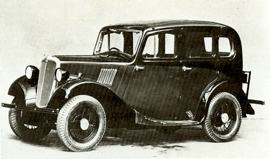 |
|
 |
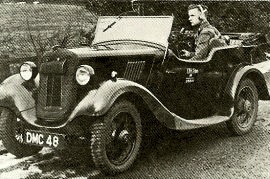 |
 |
Morris Eight Tourer |
| |
Also see: Morris Car Reviews | The History of Morris (AUS Edition) |
| |
The Morris Eight Tourers were used in some quantity by the British Army as signals cars. In June, 1935, the Eight was designated Series I. They retained the 22·5-bhp 918-cc (57 x 90 mm) side-valve engine and three-speed gearbox. Note the military cross-country-type tires and the radiator muff. |
|
 |
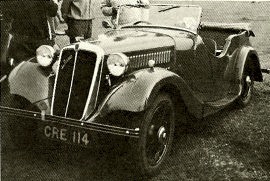 |
 |
Morris/Jensen Eight Sports Tourer |
| |
Also see: Morris Car Reviews | The History of Morris (AUS Edition) |
| |
This was one of about one hundred cars with special bodywork by Jensen Motors Limited of West Bromwich. As Michael Sedgwick put it: 'Jensen's idea of a Series I sports four-seater was pleasing but it was also a lot more expensive than the standard model, and lacked the latter's elegant simplicity'. The standard model cost £120, the Jensen £165. |
|
 |
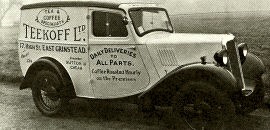 |
|
 |
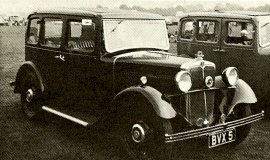 |
 |
Morris Ten-Four Saloon |
| |
Also see: Morris Car Reviews | The History of Morris (AUS Edition) |
| |
The Morris Ten-Four Saloon was available with Sliding-head at £175 and with Fixed-head at £169 10s. The 10 HP 1292-cc (63·5x102 mm) four-cylinder side-valve engine developed 26·5 bhp. Except for the Eight all Morrises had four-speed gearboxes. |
|
 |
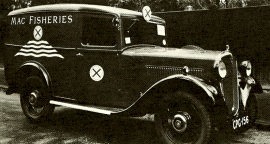 |
 |
Morris Twelve-Four |
| |
Also see: Morris Car Reviews | The History of Morris (AUS Edition) |
| |
The Morris Twelve-Four (formerly Cowley Four) was available in chassis form at £130 and formed an ideal basis for a medium capacity delivery van. This model had an 8 ft 6 in wheelbase and 5·00-19 tires. Engine was 11·9 HP side-valve Four of 1550cc capacity (69·5 x 102 mm). Saloons were available on this chassis with or without sliding roof. |
|
 |
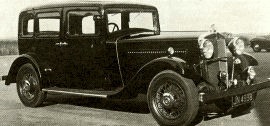 |
 |
Morris Oxford Sixteen |
| |
Also see: Morris Car Reviews | The History of Morris (AUS Edition) |
| |
The Morris Oxford Sixteen had six-cylinder side-valve engine, four-speed synchromesh gearbox with Bendix automatic clutch control. It had a 9 ft 6 in wheelbase and 5·50-17 tires. Saloon (shown) and Special Coupe body styles were available, costing £285 and £305 respectively. There was a choice of engines: 2062-cc (65·5 x 102 mm, 39 bhp) or 2561-cc (73 x 102 mm, 52 bhp). The latter was known as the Oxford Twenty. |
|
 |
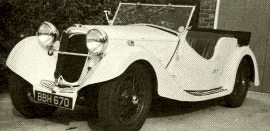 |
 |
Riley 1½- liter 12 HP Series Falcon, Kestrel and Lynx |
| |
Also see: Riley Car Reviews | The History of Riley |
| |
Riley 1½- liter 12 HP Series was new for 1935 and comprised Falcon and Kestrel Saloons and the smart Lynx Open Tourer. The engine was a 46-bhp pushrod OHV Four with a cubic capacity of 1496 cc (69 x 100 mm) and a treasury rating of 11·81 HP. |
|
 |
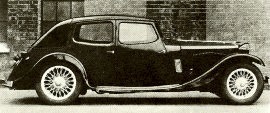 |
 |
Riley Kestrel Saloon |
| |
Also see: Riley Car Reviews | The History of Riley |
| |
The Riley Kestrel Saloon body style was produced during 1932-39. It featured a sharply sloping tail 'fastback', with the typical Riley style side windows and was available on several of the company's four- and six-cylinder chassIs. |
|
 |
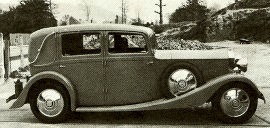 |
 |
RolIs-Royce 20/25 Saloon Landaulette |
| |
Also see: Rolls-Royce Car Reviews | The History of Rolls-Royce |
| |
This RolIs-Royce 20/25 Saloon Landaulette was supplied by Dorking Motor Co Ltd in 1935. The 20/25 chassis, costing £1050, had a wheelbase of 11 ft and was used by several coachbuilders. The engine was a 3669-cc (82 x 114 mm) six-cylinder, rated at 25·3 HP, with seven-bearing crankshaft. |
|
 |
|
|
 |
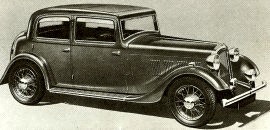 |
 |
Rover Twelve |
| |
Also see: Rover Car Reviews | The History of Rover (AUS Edition) |
| |
The Rover Twelve was available in Saloon, Sports Saloon (pictured left) and Open Four-seater form. The latter two were built on an 8 ft 9 in chassis (like the Rover Ten), the Saloon on 9 ft 4 in. The Twelve chassis was available, at £195, with either wheelbase size. Engine was a 1½-liter OHV Four, rated at 11·9 HP but developing 48 bhp at 4200 rpm. Gearbox was fourrspeed with freewheel. |
|
 |
|
 |
Rytecraft Scootacar |
| |
|
| |
Rytecraft Scootacar was the name of the petrol-engined development of an electric 'dodgem' car, produced by the British Motor Boat Mfg Co Ltd in London during 1934-40. This 1935 model, powered by a 98-cc Villiers Midget industrial engine, was driven round the world in 1965/66 by its enterprising owner Mr Jim Parkinson, shown here at a Redhill, Surrey, school fete after his return. |
|
 |
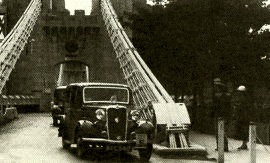 |
 |
Singer Nine, Eleven, 1½-liter, Fourteen and Sixteen |
| |
Also see: Singer Car Reviews | The History of Singer |
| |
Singer offered a wide range of models on their Nine, Eleven, 1½-liter, Fourteen and Sixteen chassis. Shown is an Eleven Saloon, crossing Conway Bridge during the Welsh Rally, 1935. |
|
 |
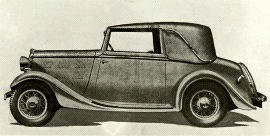 |
 |
Singer Eleven Drop-head Coupe |
| |
Also see: Singer Car Reviews | The History of Singer |
| |
The Singer Eleven Drop-head Coupe was priced at £275. The Eleven featured independent front suspension (as did certain Nine models) and had Fluidrive transmission Engine was a 10·5 HP OHC Four of 13B4-cc (65 x 105 mm) capacity, developing 35 bhp. Wheelbase was 8 ft 4 in. |
|
 |
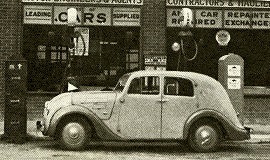 |
 |
Singer Eleven Airstream Saloon |
| |
Also see: Singer Car Reviews | The History of Singer |
| |
The Singer Eleven Airstream Saloon was carry-over from the previous model year. Price was £300. It was not continued for 1936. Like the other Elevens it had independent front suspension and Fluidrive transmission with freewheel and clutch-less gear change. |
|
 |
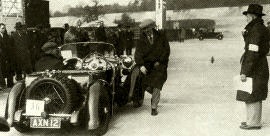 |
 |
Singer Nine Le Mans Two-seater |
| |
Also see: Singer Car Reviews | The History of Singer |
| |
Singer Nine Le Mans Two-seater at Brooklands. The Le Mans models had basically the same 972-cc engine as the standard Nines but with twin carbs, developing 34 bhp (Speed model 38 bhp). The Two-seater cost £215. |
|
 |
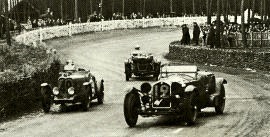 |
|
 |
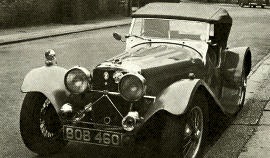 |
 |
SS 90 |
| |
Also see: Jaguar Car Reviews | The History of Swallow Sidecars |
| |
The SS 90 was a 90-mph two-seater sports car and appeared in March, 1935. It had a 2663.7cc (73 x 106 mm) six-cylinder side-valve engine. Power output was 68 bhp at 3600 rpm. At the rear there was a slab-mounted fuel tank and a vertically mounted spare wheel. This car was the immediate predecessor of the famed SS Jaguar 100. |
|
 |
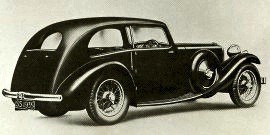 |
 |
SS I Airline Saloon |
| |
Also see: Jaguar Car Reviews | The History of Swallow Sidecars |
| |
The SS I Airline Saloon was available with 53-bhp 2143cc (65·5 x 106 mm) 15·96 HP engine or with 68-bhp 2663·7cc (73x106 mm) 19·84 HP variant. Both were side-valve six-cylinders. Wheelbase was 9 ft 11 in for both types. Saloon and Tourer bodystyles were available on the same chassis, as well as on 8 ft 8 in wheelbase four-cylinder 10 and 12 HP SS II variants. |
|
 |
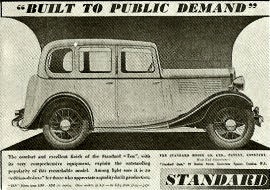 |
 |
Standard Ten |
| |
Also see: Standard Car Reviews | The History of Standard |
| |
The Standard Ten had a 1343-cc (63·5 x 106 mm) four-cylinder engine, rated at 10 HP, and 7 ft 10 in wheelbase. There was also a Ten-Twelve Speed Saloon variant with twin-carburetor high-compression 12 HP engine. |
|
 |
|
 |
Stoewer Tourer |
| |
Also see: The History of Stoewer |
| |
1935 Stoewer Tourer. It was during this period that the company found itself in dire financial difficulty, forcing the State of Prussia to intervene to ensure the safety of the jobs of the Stoewer workforce. Early in 1936, Hitler's economic delegate, Wilhelm Keppler, proposed a merger between Stoewer and the Cologne-based Ford of Germany. The union, originally conceived by the Kaiser's grandson, Prince Louis Ferdinand, who was an admirer of both Henry Ford and Adolf Hitler, seemed to have much to commend it; Ford was losing German sales because of its American and British connections, while Stoewer was just losing money. But the books were cooked, and Ford did not go ahead with the merger plans. |
|
 |
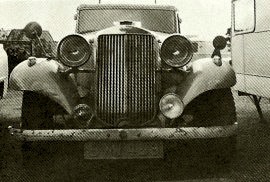 |
 |
Sunbeam 12·8 HP Four and 19·8.20·9 and 23·8 HP Six |
| |
Also see: Sunbeam Car Reviews | The History of Sunbeam |
| |
Sunbeam offered 12·8 HP Four and 19·8.20·9 and 23·8 HP Six models. This six-cylinder example was still operational in Devon in the late 1960s. |
|
 |
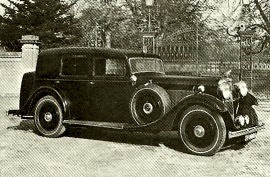 |
 |
Sunbeam Twenty-Five (23·8 HP) Limousine |
| |
Also see: Sunbeam Car Reviews | The History of Sunbeam |
| |
Sunbeam Twenty-Five (23·8 HP) Limousine, acquired by HRH The Duke of Gloucester in March. 1935. It had a 3317·5cc (80 x 100 mm) OHV six-cylinder engine and 11 ft 4 in wheelbase SWB Twenty-Fives (10ft 10 in) were easily distinguishable by not having the headlamp tie bar in front of the radiator. |
|
 |
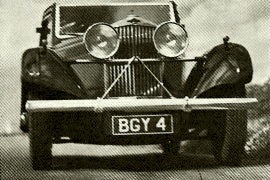 |
 |
Talbot Seventy-Five Special Drop-frame Sports Saloon |
| |
Also see: The History of Talbot |
| |
The Talbot Seventy-Five Special Drop-frame Sports Saloon (Model BA75) was one of three saloons available. It cost £565 and had a 17·9 HP 70-bhp six-cylinder OHV engine of 2276-cc capacity (69,5 x 100 mm). The transsmission was of the automatic four-speed pre-selecting type. |
|
 |
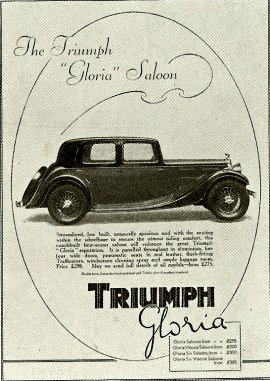 |
 |
Triumph Gloria Fours and Sixes |
| |
Also see: Triumph Car Reviews | The History of Triumph |
| |
Triumph model range comprised Gloria Fours and Sixes. all with Coventry Climax engines with overhead inlet and side exhaust valves. The cheapest model was the 10·8 HP Gloria Four Southern Cross Two-seater. at £275. At the other end of the scale was the 15·72 HP Gloria Vitesse Six Flow-Free Saloon. priced at £425. |
|
 |
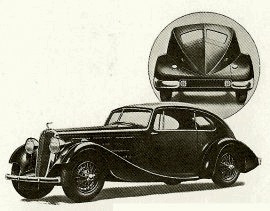 |
 |
Triumph Gloria Vitesse Six Flow-Free Saloon |
| |
Also see: Triumph Car Reviews | The History of Triumph |
| |
The Triumph Gloria Vitesse Six Flow-Free Saloon had very smart appearance. This body was mounted only on the Vitesse chassis which had a specially tuned engine, developing 65 bhp. All Triumphs featured a free-wheel and remote control gear selection, as well as Lucas Startix ignition systems. Twin fuel tanks were located in the rear wings. |
|
 |
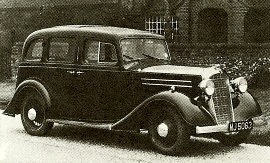 |
 |
Vauxhall Light Six D-Series |
| |
Also see: Vauxhall Car Reviews |
| |
The Vauxhall Light Six D-Series was launched in late 1934, and comprised DY 12 HP and DX 14 HP models. They superseded the 1933-34 A-series and featured independent front wheel suspension. Prices for 12 and 14 HP were the same: chassis £150, Saloon (12 HP only) £205, Saloon De Luxe £225. The 1531 -cc (57 x 100 mm) and 1781 -cc (61 '5 x 100 mm) OHV engines had an output of 36 and 42 bhp respectively. |
|
 |
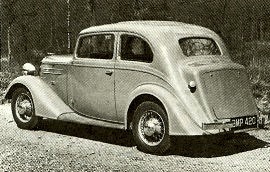 |
 |
Vauxhall Light Six DY and DX |
| |
Also see: Vauxhall Car Reviews |
| |
The Vauxhall Light Six DY and DX chassis were available at £150 for special coachwork such as this four-seater Coupe. |
|
 |
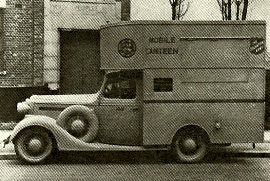 |
 |
Vauxhall Big Six B-series |
| |
Also see: Vauxhall Car Reviews |
| |
The Vauxhall Big Six B-series was available with 19.8 HP 2392-cc (73 x 95·25 mm) or 26·3 HP 3180-cc (84·14 x 95,25 mm) OHV Six engine. These models were designated BY and BX respectively. Standard wheelbase was 9 ft 3 in but a long-wheelbase version, Model BXL, was available with the 26·3 HP engine. With seven-seater Limousine bodywork the BXL sold at £550. Pictured left is a wartime Salvation Army mobile canteen, paid for by the inhabitants of Wellesley, Massachusetts, USA, through the British War Relief Society, was a 1939/40 conversion of the standard-wheelbase Saloon. |
|
 |
|
|
|
